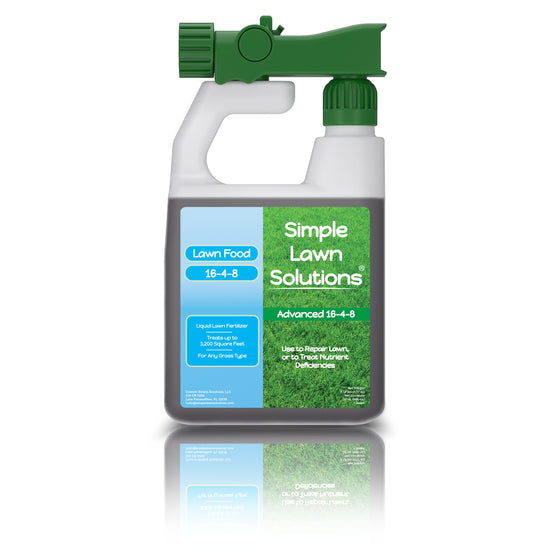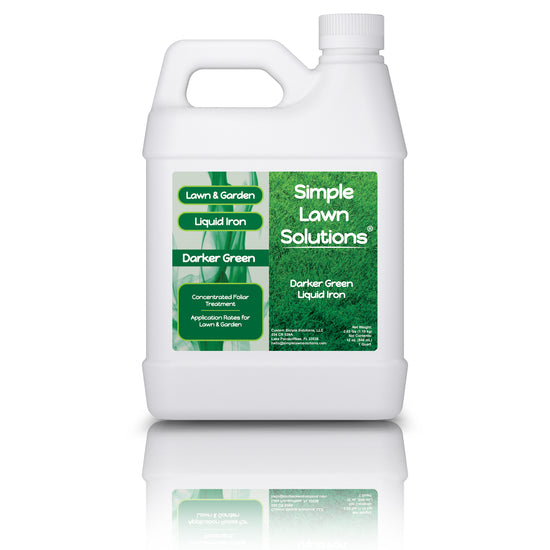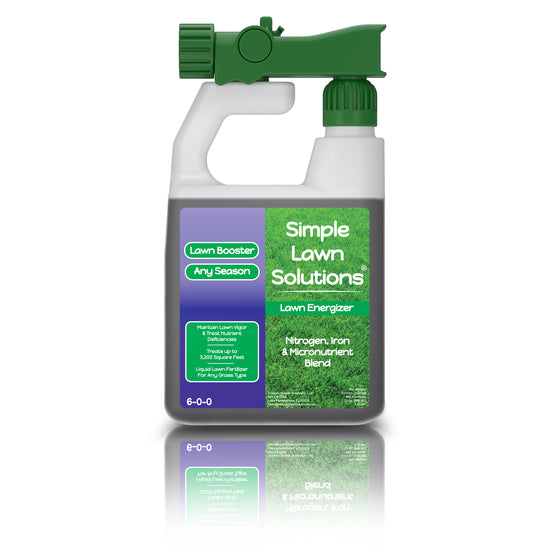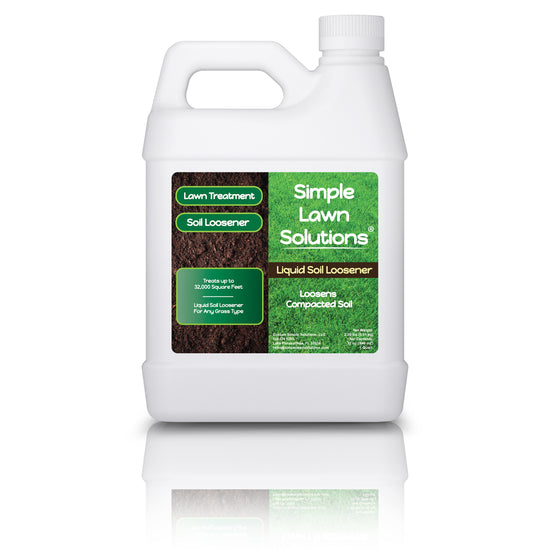Yellow grass can be caused by a variety of lawn ailments. From nutrient deficiency to lawn disease, soil compaction can cause yellow grass. In this blog, we’ll look at the what the main causes of yellow grass are, and how to prevent them for a greener lawn.
What Causes Yellow Grass?
Yellow grass can be caused by a variety of lawn ailments. The main reasons grass can turn yellow are due to the following:
-
Dog Urine
-
Lawn Diseases (Dollar Spot, Brown Patch, Rust Fungus)
-
Grubs and Chinch Bugs
-
Nitrogen and/or Iron Deficiency
-
Over-fertilization (Fertilizer Burn)
-
Over or Underwatering
-
Soil Compaction
-
Lawn Dormancy
-
Incorrect Mowing Practices (Scalping, Dull Mower Blades)
-
Applying the Wrong Products
The Root of the Issue: How to Tell What is Causing my Grass to Turn Yellow?

Dog Urine
Dog urine spots are one of the most common causes of yellow or brown patches in lawns. Dog urine burns turfgrass primarily due to its high concentration of nitrogen and associated salts.
The damage appears as circular or irregular yellow patches surrounded by a dark green ring. The outer ring stays green because diluted urine contains urea, while the center turns yellow or brown from high salt concentration.
If you notice new yellow spots appearing soon after your dog uses the yard, especially in consistent areas of the lawn, dog urine is likely the culprit. The patches are typically isolated and small, about 3–6 inches across, and may reappear in similar locations.
Lawn Diseases (Dollar Spot, Brown Patch, Rust Fungus)
Fungal diseases often cause irregular yellow or tan patches, and common culprits include dollar spot, brown patch, and rust fungus.
Dollar spot: Small, circular yellow or straw-colored spots about the size of a silver dollar.
Brown patch: Larger, circular areas (6–12 inches wide) that appear suddenly during humid or rainy weather.
Rust fungus: Grass blades appear dusty or orange-yellow when brushed, leaving a powdery residue on shoes or mower blades.
Grubs and Chinch Bugs
Grubs and chinch bugs both damage grass by feeding on grass, but their symptoms differ slightly.
Grubs (larvae of beetles): The grass turns pale yellow to brown, wilts easily, and feels spongy. You can do a tug test to check this. The turf often lifts like a carpet because the roots have been eaten away. You may also notice an increased presence of birds in your yard, digging for the larvae to eat.
Chinch bugs: Damage starts as small yellow patches in sunny areas, especially during hot, dry weather. Chinch bugs damage turfgrass by feeding on the plant's fluids and injecting a toxic saliva. The grass looks straw-colored and may have a fine, speckled appearance on the blades. Chinch bug damage typically expands outward over time. If you peel back the turf and spot white, C-shaped grubs or tiny black-and-white chinch bugs near the soil surface, you’ve found the cause.
Nitrogen and/or Iron Deficiency
Nitrogen Deficiency: Grass needs nitrogen for its rich green color. A deficiency leads to pale, yellow-green blades and slow, thin growth. Unlike patchy issues, nitrogen deficiency typically causes uniform yellowing across large sections of the lawn. Older blades (toward the base) turn yellow first, while newer blades remain slightly greener. If fertilizing brings back the green within a week or two, nitrogen deficiency was the problem.
Iron Deficiency: Also known as iron chlorosis, causes grass blades to turn pale yellow or light green, while the veins remain darker green. This creates a faint striped pattern on grass blades. Unlike a nitrogen deficiency, which affects the entire plant evenly, iron deficiency shows up first on new growth, while older leaves may stay green.
You’ll typically notice this issue in early spring or summer, especially when soil conditions make iron less available to roots. High soil pH (alkaline soils), excessive phosphorus, or compacted clay can all contribute to this problem.
Over-fertilization (Fertilizer Burn)
Excess fertilizer can cause yellow or brown streaks or patches, especially in areas where there is a concentrated and uneven application. Grass blades may look scorched and crispy at the tips, and the damage often appears a day or two after fertilizing.
If you notice yellowed areas following a recent fertilizer application, particularly along driveways or edges, fertilizer burn is the likely cause. These spots often have sharp boundaries between healthy and damaged grass.
Soil Compaction
Compacted soil prevents roots from getting enough air, water, and nutrients. When compacted soil is the culprit, yellowing occurs in high-traffic areas like walkways or spots where equipment or kids frequently travel.
You’ll notice thinning grass, poor drainage, and hard, dense soil that’s difficult to penetrate with a screwdriver or shovel. Water tends to pool or run off instead of soaking in. Core aeration is the best fix for this issue.
Over or Underwatering
Both overwatering and underwatering can cause yellowing, but they show up differently.
Overwatering: The lawn feels mushy or soggy, and grass may turn light yellow or pale green from oxygen deprivation and shallow roots. You may also see moss or mushrooms growing in a circular pattern, also known as "Fairy Ring" disease
Underwatering: Grass turns dry, dull yellow, and footprints stay visible after walking on it. Soil feels hard and dry, and blades may curl inward.
You can check moisture levels by pushing a screwdriver into the soil — if it’s difficult to insert, the soil is too dry; if water pools easily, it’s too wet.
Lawn Dormancy
During summer and winter, grass naturally goes dormant to survive stress from heat or cold. Warm-season grasses (like Bermuda or Zoysia) turn yellow or tan in cooler months, while cool-season grasses (like Fescue or Rye) turn yellow during extreme summer heat or drought.
If the yellowing is seasonal and uniform across the lawn (without patches or dead spots), and the grass blades are still flexible rather than brittle, it’s likely lawn dormancy. The lawn should green up again when conditions improve.
Incorrect Mowing Practices (Scalping, Dull Mower Blades)
Scalping (Mowing too Short): Scalping the lawn removes too much of the grass blade, exposing the crown and soil to sun stress. You’ll see yellow or brown streaks where the mower scalped too close, often more visible on uneven ground. Each grass type has an optimal height of cut, so it’s important to understand what grass type you have and adjust mowing heights accordingly.
It’s never recommended to mow more than a third of the grass at a time. Mowing over 30% of the height of your grass, especially during hot and dry conditions, is a recipe for yellow grass.
Dull Mower Blades: When mower blades are dull, they tear grass instead of slicing it cleanly. Torn blades have frayed, brown edges, giving the whole lawn a yellow or tan cast.
You may notice the yellowing a day or two after mowing and find that individual blades have shredded tips upon closer inspection. Sharpen mower blades every 20–25 hours of use to prevent this.
Applying the Wrong Products
Herbicides, pesticides, and other lawn treatments can damage grass if applied at the wrong rate or time. Chemical burn looks like irregular yellow or brown patches appearing within days of treatment.
You might see discoloration in areas near sidewalks or where the sprayer overlapped, or along edges where excess product collected. Check the product label for safe use rates and avoid applying during high heat or stress.
Is Yellow Grass Dead?
Depending upon the root cause of the yellowing of the grass will inform how likely it is that it’s dead or is dying.

If Grass is Alive (stressed or dormant):
-
The blades are yellow or tan, but the crown at the base is white or cream-colored and firm to the touch.
-
The grass may bend instead of snapping when tugged.
-
You may notice tiny green shoots emerging from the crown if moisture and temperature conditions improve.
Dead Grass:
-
The crown is dark brown, black, or mushy — this means rot or dehydration has killed the plant.
-
Blades are crispy, brittle, and break easily.
-
There are no signs of new growth even after watering or favorable weather.
You’ll also want to look at root health, as roots are key to a thriving lawn. Grab a small handful of grass and gently pull upward. If the grass resists and stays rooted, it’s still alive. If the grass pulls up easily and the soil beneath is bare, the roots are dead or severely damaged. It’s recommended to try the tug test (also known as the tensil strength test), in multiple areas of the lawn, as sometimes only certain sections of the lawn are affected.
Water the yellowed area thoroughly for 7–10 days. If the problem is due to drought stress, dormancy, or mild fertilizer burn, you’ll start to see new green shoots pushing through. If there’s no visible improvement after 2 weeks, it’s likely dead and will need to be reseeded or patched.
Consider the season and your grass type. Sometimes grass looks dead, but it’s actually dormant. Cool-season grasses like fescue, rye, or bluegrass may turn yellow or brown in hot summer months but recover in fall. Warm-season grasses, like Bermuda, Zoysia, or St. Augustine, may go yellow or tan in winter dormancy and green up again in spring.
If it’s the off-season for your grass type and the lawn feels firm and uniform, it’s probably dormant, not dead.
When is the Right Time to Fertilize to Fix Yellow Grass?
Before reaching for nitrogen or iron fertilizer, make sure yellowing is actually from nutrient deficiency and not another issue like overfertilization, drought, pests, or disease. Fertilizing too soon or for the wrong reason can make the issue worse, especially if the lawn is stressed by heat or dryness.

Best Time to Fertilize
Fertilizer works best when your lawn is actively growing, the soil is moist, and temperatures are mild.
Cool-season grasses (like fescue, ryegrass, and bluegrass): Fertilize in spring or early fall, when soil temperatures are between 50–65°F.
Warm-season grasses (like Bermuda, Zoysia, St. Augustine): Fertilize in late spring through summer, when soil temperatures are consistently above 65°F.
Avoid fertilizing:
-
During extreme heat or drought
-
Right before heavy rain
-
When the grass is dormant or frozen
Fixing Yellow Grass with Nitrogen and Iron Fertilizer: Yellow Grass Fertilizer
If your lawn’s yellowing is due to a nutrient deficiency, use a lawn fertilizer that targets the specific problem. If you have a nitrogen deficiency on your hands, apply nitrogen lawn fertilizer in early to mid spring, like 28-0-0, or 15-0-15 lawn fertilizer. Nitrogen (N) is the most important nutrient for lawns, driving leaf growth, color, and density. It’s what gives grass that lush, deep green appearance.
Use an iron fertilizer to address iron chlorosis, like Lawn Energizer or Darker Green. Iron (Fe) is an essential micronutrient that helps plants produce chlorophyll, the pigment responsible for the green color in grass blades.
Iron fertilizer provides this nutrient in a form the grass can absorb quickly — restoring color without excessive top growth.










